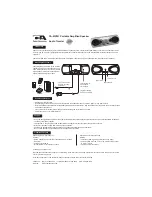
LOADING:
It is impossible to outline the exact limitations for loading a shaker, as resulting
shaking action is dependent upon several factors. Principle among these is the
size and shape of the containers, speed, length of stroke, and the amount and
type of material being shaken.
Basic considerations should be:
•
Use lowest speed consistent with the required shaking action.
•
At higher speed use less weight on the platform.
•
At lower speeds, weight on platforms and/or length of stroke can be increased
up to 50lbs Maximum.
•
When using one platform tiered above the other, place equal load on each, or
if it is possible, place heavier mass on lower platform and lighter on the top. If
shaking action impart
s a “whip” to the upper platform, then either the speed is
too high or the load is too heavy on that platform.
•
If shaker has tendency to “walk” on floor, then rubber suction cup feet should
be secured to the floor using rubber or contact cement.
For optimum operation of this shaking apparatus and for long trouble-free life, it
is recommended that a minimum load be placed in the shaker when used.
Good judgment in the selection of the factors will contribute to proper use of the
shaker.
OILING AND ALL MAINTENANCE CAN BE PERFORMED BY REMOVING
EITHER THE FRONT OR REAR HOUSING PANEL.
BELT INSPECTION:
Inspect belts at each oiling period and replace if broken or if the cords are
exposed and frayed. Small outer fabric breaks are not harmful.
BELT ADJUSTMENT:
The motor belt driving the 9" idler pulley may stretch and become loose after a
short time in operation, or the replacement belt may be a slightly different length.
To adjust the belts, first run the shaker and dial in to the slowest speed. Turn off
the shaker and prop up shaker so bottom fasteners are accessible. Then
remove the front panel. Near the center of the bottom will be four hex head cap
screws that hold the motor. Loosen the four hex head cap screws holding the
motor and adjust the motor belt to proper tightness. Tighten the motor screws,
but do not tighten either belt to the point where the bearings will be overloaded.
When a belt is tight, the operator should be able to press lightly on the middle of
the belt and cause it to bow in an amount equal to the width of the belt.
Contact Eberbach Tech Support
(800) 422-2558
for instructions on replacement
of belt between idler assembly and crankshaft assembly.








































